
About Andrew Cusack
 Writer, web designer, etc.; born in New York; educated in Argentina, Scotland, and South Africa; now based in London.
Writer, web designer, etc.; born in New York; educated in Argentina, Scotland, and South Africa; now based in London. read more
News
Blogs
Reviews & Periodicals
Arts & Design
World
France
Mitteleuropa
Knickerbockers
Argentina
The Levant
Africa
Cape of Good Hope
Netherlands
Scandinavia
Québec
India
Muscovy
Germany
Academica
Arms of the Irish Universities
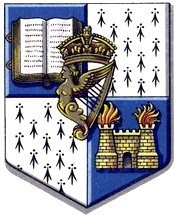 University of Dublin
University of DublinUniversitas Dublinensis; Ollscoil Átha Cliath
Dublin University was founded with the idea of creating a collegiate university along the Oxford and Cambridge model. The University of Dublin, however, failed to develop along those lines, and so its sole foundation was the College of the Holy and Undivided Trinity of Queen Elizabeth near Dublin, more commonly known as Trinity College. Strictly speaking, TCD and the university are distinct entities in law, Trinity being the only college of the university.
The university’s arms, granted in the nineteenth century, are blazoned Quarterly azure and ermine. First quarter a book open proper, bound gules, clasped or, and in fourth quarter a castle of two towers argent, flamant proper. Overall in the centre point the harp of Ireland ensigned with the royal crown. The castle with fired towers is a reference to the arms of the city of Dublin. While it is the university, not Trinity College, that awards degrees, the university arms were not used on degree certificates until 1963, when President John F. Kennedy was granted an honorary doctorate of law in St. Patrick’s Hall at Dublin Castle.
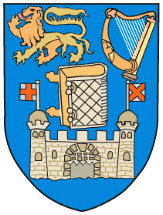 Trinity College, Dublin
Trinity College, Dublin
Trinity College uses arms first depicted in 1612; there is no record of a grant, but they were confirmed in 1901. They are blazoned Azure, a Bible closed, clasps to the dexter, between in chief, on a dexter a lion passant, on the sinister a harp, all or, and in base a castle with two towers domed, each surmounted by a banner flotant from the sides, argent, the dexter flag charged with a cross, the sinister with a saltire, gules.
The banner flotant from the tower on the viewer’s left is, of course, the English flag, while that on the right bears the Fitzgerald arms, the red saltire on a white background. These arms were later elevated to the rank of a national emblem, and when the kingdoms of Ireland and Great Britain were joined, the “St. Patrick’s Cross” (as it became known) was added to the Union Jack, where it remains to this day.
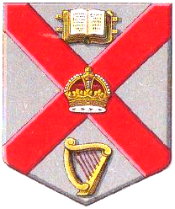
In the nineteenth century, the United Kingdom government became concerned about the lack of access to university education in Ireland. Catholics were first admitted to Trinity in 1793, but restrictions of one kind or another remained until 1873. The majority of the Catholic population was still restrained from education at the University of Dublin because the Catholic hierarchy feared allowing Catholic students to be taught in Protestant institutions. The government attempted to respond to Ireland’s lack of universities by founding Queen’s College, Belfast; Queen’s College, Cork; and Queen’s College, Galway, in 1845. These were then made parts of the degree-awarding Queen’s University of Ireland in 1850.
The Queen’s University arms employed a number of emblems. A crown superimposed on the St. Patrick’s Cross emphasised the royal patronage; the open book symbolised learning, while the harp below again represented Ireland.
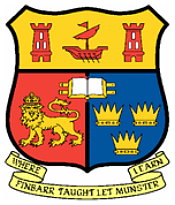
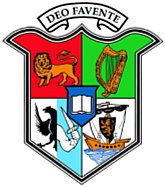
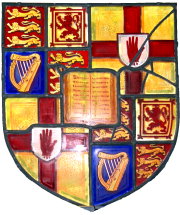
Queen’s College Cork, Queen’s College Galway, Queen’s College Belfast
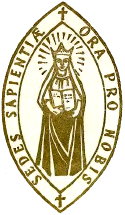
The Catholic population remained wary of the non-sectarian Queen’s Colleges. The church hierarchy felt threatened by the new institutions, banned Catholics from attending them, and in response founded the Catholic University of Ireland in 1854. Five faculties — law, letters, medicine, philosophy, theology — were founded under the rectorship of the famed English divine, Blessed John Henry Newman. The university was intended not solely to serve the Irish but to be a great Catholic university for all of the United Kingdom of Great Britain & Ireland. Of the first eight students, two were Irish (one a baronet), two English, two Scottish (including the grandson of a marquis), and two French (one a viscount, the other the son of a countess). They were soon joined by two Belgian princes and a Polish count.
£250,000 was raised from the Irish faithful and other concerned souls, but the Irish bishops were very suspicious of Newman for being English, intellectual, and Protestant-born. Newman left in 1857 and the university tumbled into decline. The bishops, as trustees of the money raised, sent most of the university’s endowment to help fund the 1867 defense of Rome from Garibaldi’s attempt to take the Eternal City. By 1879, the Catholic University of Ireland had only three students enrolled.
The university never adopted arms, but used a vesica-shaped emblem of the Blessed Virgin as Seat of Wisdom.
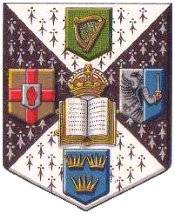
In 1880, the Royal University of Ireland was founded as a degree-awarding institution whose exams could be taken by any, whether they had attended lectures organised by the university or not. Therefore one could be educated at any place of learning but earn a degree recognised by the civil authorities, unlike the degrees of the Catholic University.
The arms of the Royal University included the shields of the four provinces of Ireland — Leinster, Connacht, Munster, and Ulster — on a counterchanged ermine field, around a crowned open book.
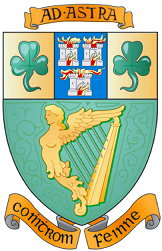
Since the Royal University of Ireland could now award the degrees, the Catholic University refounded its undergraduate division as University College Dublin. From 1880, the college developed successfully, reversing the previous downward spiral. Between 1893 and 1908, the Royal University awarded 708 first class degrees in arts were to UCD students, compared to 486 to students of Belfast, Galway, and Cork combined. The poet Gerard Manley Hopkins was professor of Greek literature, while the nationalist & revolutionary Eoin MacNeil taught early Irish history. Douglas Hyde, who later served as Ireland’s first president, was professor of Irish, and had for a student Cearbhall Ó Dálaigh, also a future president of the republic.
University College Dublin obtained its arms, so far as my research can tell, in 1911. Its central symbol is the obvious Irish emblem of the harp, with the ‘fired’ castle from Dublin’s civic arms flanked in the chief by two shamrocks. Since 2005, UCD moved away from using its coat of arms in favour of a pseudo-heraldic ‘brand mark’ to be used for ‘all UCD visual identity and communications uses’. The coat of arms would continue to be used, however, for ‘ceremonial purposes’ such as degrees, diplomas, certificates, and ‘prestige items’.
The arms are blazoned: Vert a harp or stringed argent, on a chief of the second on a pale azure between two trefoils slipped vert three castles flammant proper.
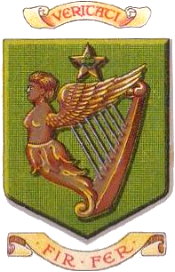
The 1908 Irish Universities Act in some ways anticipated educationally the growing separatist tide of Ulster Protestantism. The act dissolved the Royal University and raised the Belfast college to university status while the remaining colleges at Dublin, Galway, and Cork became university colleges of the new National University of Ireland.
Unfortunately I can find little on hand about the origins of NUI’s coat of arms. They are admirable in their simplicity: a Brian Boru harp on a green field, with a shamrock’d star above. The National University of Ireland has followed UCD’s lamentable trend of disregarding its coat of arms for a psuedo-heraldic logo of a gold harp on a funkified shield with the star-and-shamrock moved out, floating above the shield. The new logo is a heraldic anomaly, because removing the star-and-shamrock from the shield makes it identical to the provincial arms of Leinster, thus creating cross-purposes of identification. Is it the National University of Ireland, or of Leinster? One would hope that a learned institution, especially one in a country with a heraldic authority, would be able to avoid such visual confusion.
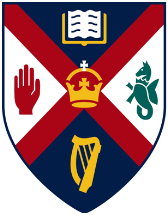
Two years after QUB was established in 1908, it was granted its own arms different from those of its preceding institution, Queen’s College Belfast. The university’s arms are blazoned as: Per saltire azure and argent, on a saltire gules, between in chief an open book and in base a harp both proper, in dexter a hand couped of the third, and in sinister a sea-horse vert gorged with a mural crown of the fourth, an Imperial crown of the last.
The Red Hand of Ulster and the Irish harp are apparent, and the seahorse is used as an emblem representing Belfast. The crown for the royal connection is imposed upon the St Patrick’s Cross, which can also be interpreted as harkening back to the Saltire to represent the Ulster Scots.
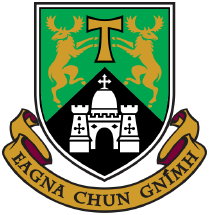
The University of Limerick was first established as the National Institute of Higher Education, Limerick in 1972. It was granted university status in 1989, the same day as Dublin City University. I’m afraid I can’t find much info on the background of this university’s coat of arms. The domed castle in the lower portion is definitely taken from the city’s coat of arms, but the rest of the symbolism — the elk supporting the Tau cross — escapes me.
I can at least tell you the Irish motto of Eagna chun gnímh translates as ‘wisdom in action’.
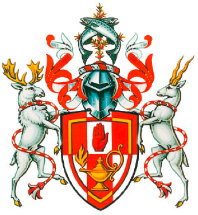
The New University of Ulster was founded in 1968, and later merged with the Ulster Polytechnic in 1984 to become the University of Ulster. A year later, the College of Arms granted this achievement to the institution. The six alternating panels represent the six counties of Northern Ireland. The red hand, again, symbolises Ulster, while the lamp stands for learning. The supporters are an antelope — commemorating the University’s first chancellor, the 4th Duke of Abercorn — and an Irish elk from the provincial arms.
The University of Ulster is one of those unfortunate institutions which severely restricts the use of its coat of arms. The full arms are only to be used by the vice-chancellor’s office, on degree parchments, on external signs, on sanctioned memorabilia, on on plaques. The shield from the arms can also be used on “approved sports kit”. Such restrictions might be appropriate for the use of a seal (which implies university approval, agreement, or acceptance), but coats of arms are badges of identity meant to be more freely used.
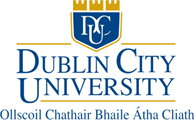
Having been granted university status later on the same day as the University of Limerick, Dublin City University is Ireland’s newest university. It has risen in prominence during the decade-long tenure of Prof. Ferdinand von Prondzynski as its president from 2000 to 2010.
It appears that DCU has no coat of arms, but did for some time employ a pseudo-heraldic emblem with the university’s acronym on a blue shield appropriately topped by three castles from Dublin’s civic arms. Prondzynski dumped the dated logo for something a bit more up to date, but if the Chief Herald of Ireland has yet to grant arms to the institution, it is probably for lack of applying.
Search
Instagram: @andcusack
Click here for my Instagram photos.Most Recent Posts
- Sag Harbor Cinema March 26, 2025
- Teutonic Takeover March 10, 2025
- Katalin Bánffy-Jelen, R.I.P. March 3, 2025
- Substack Cusackiensis March 3, 2025
- In the Courts of the Lord February 13, 2025
Most Recent Comments
Book Wishlist
Monthly Archives
Categories



I am sorry to see that Ireland has begun to copy the rest of the degenerate world by establishing more and more entities calling themselves universities. One might be allowed to hope that the country’ small population, allied to the current economic crisis, will curtail any more of such puerile nonsense.
The situation in England is ludicrous (and was begun, never let it be forgotten, by a “Tory” administration): the rash of polytechnics now called universities includes one which is housed in a disused cinema and which regularly comes bottom of the league tables of whatever standards might still exist.